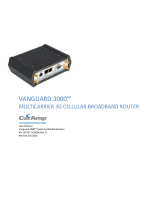3G Mobile Router User Manual
Table of Contents
1 FOR YOUR SAFETY......................................................................................................................................4
2 PRODUCT OVERVIEW...............................................................................................................................5
2.1 Introduction................................................................................................................................................5
2.2 Package contents........................................................................................................................................5
2.3 System requirements..................................................................................................................................5
2.4 Hardware. LED's and connections.........................................................................................................6
2.4.1 Back panel............................................................................................................................................6
2.4.2 Front panel..........................................................................................................................................6
3 GETTING STARTED....................................................................................................................................7
3.1 Initial setup..................................................................................................................................................7
3.2 Connect to network...................................................................................................................................7
4 ROUTER CONFIGURATION....................................................................................................................8
4.1 Connect to router WEB configuration tool using LAN connection................................................8
4.2 Connect to router WEB configuration tool using wireless LAN connection.................................9
4.3 WEB configuration interface structure................................................................................................12
4.4 Status..........................................................................................................................................................12
4.4.1 System Information.........................................................................................................................13
4.4.2 Interfaces...........................................................................................................................................13
4.4.3 Wireless..............................................................................................................................................14
4.5 Configuration............................................................................................................................................14
4.5.1 3G Network......................................................................................................................................14
4.5.2 Network.............................................................................................................................................15
4.5.3 Wireless..............................................................................................................................................16
4.5.4 Port forwarding................................................................................................................................19
4.5.5 Service................................................................................................................................................20
4.6 Admin........................................................................................................................................................21
4.6.1 Account..............................................................................................................................................21
4.6.2 Maintenance .....................................................................................................................................22
4.7 Tools..........................................................................................................................................................23
4.7.1 Site Survey.........................................................................................................................................23
5 TECHNICAL SPECIFICATION...............................................................................................................25
6 TECHNICAL SUPPORT CONTACTS....................................................................................................27




















